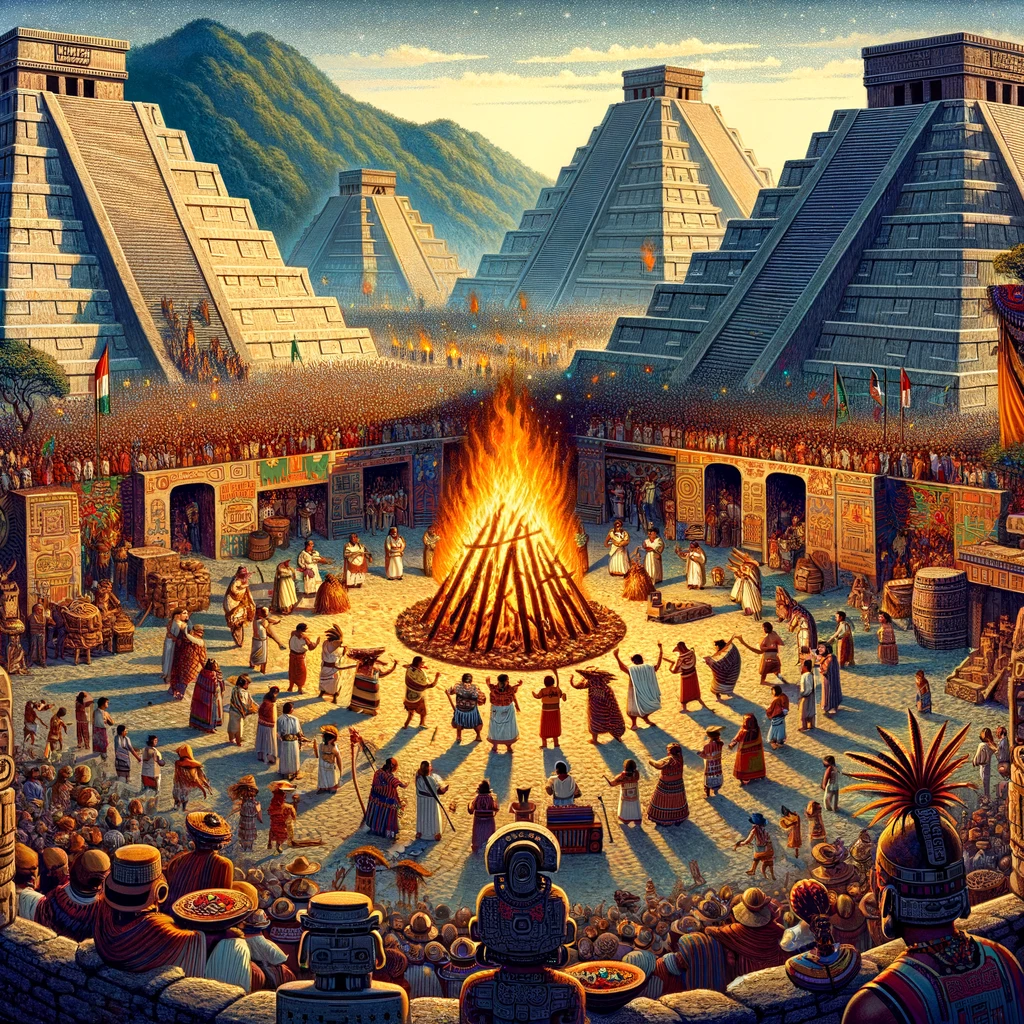
Deep in the heart of ancient Mexico, amid the grandeur of the Aztec civilization, the Xocotl Huetzi festival marked a time of reverence and celebration. Rooted in the rich cultural tapestry of the Aztec people, this vibrant festival was a testament to their deep connection with nature, their gods, and the cycles of the earth.
Origins and Meaning
The Xocotl Huetzi festival was a sacred event dedicated to Xocotl, the Aztec god of agriculture and fertility. Held during the harvest season, usually in late summer or early autumn, the festival was a time to give thanks for the bountiful crops bestowed upon the people. Xocotl, often depicted as a youthful deity adorned with maize and other agricultural symbols, was believed to preside over the growth of crops and the abundance of the earth.
The name "Xocotl Huetzi" itself holds significance. "Xocotl" refers to the ripe or unripe fruit, particularly the green fruit of the prickly pear cactus, which symbolized fertility and abundance. "Huetzi" means to weep or lament, signifying the gratitude and reverence expressed during the festival.
Rituals and Ceremonies
The festival commenced with elaborate rituals conducted by Aztec priests, who played a central role in connecting the people with the divine. These rituals often involved offerings of food, flowers, and incense to Xocotl, accompanied by prayers and chants seeking his blessings for a fruitful harvest.
One of the most striking aspects of the Xocotl Huetzi festival was the ceremonial dance performances. Dancers adorned in elaborate costumes and headdresses, representing various aspects of nature and agricultural deities, would perform intricate choreography accompanied by rhythmic drumming and chanting. These dances were believed to invoke the spirits of the earth and ensure the fertility of the land for the coming year.
Another highlight of the festival was the feasting and communal gatherings. People from far and wide would come together to share in the abundance of the harvest, enjoying a lavish spread of traditional foods such as maize, beans, squash, and various fruits. Music, dance, and storytelling filled the air as the community celebrated their interconnectedness with the natural world and each other.
Symbolism and Legacy
The Xocotl Huetzi festival was not only a time of celebration but also a profound expression of the Aztec worldview. It embodied their deep reverence for nature and the cyclical rhythms of life, as well as their belief in the interconnectedness of all living things.
Furthermore, the festival served as a reminder of the importance of stewardship of the land. The Aztecs understood the delicate balance between human activity and the natural world, and the festival provided an opportunity to reaffirm their commitment to sustainable agricultural practices.
Though the Aztec civilization has long since faded into history, the legacy of the Xocotl Huetzi festival lives on in the traditions and cultural heritage of Mexico. Today, modern interpretations of the festival continue to pay homage to the ancient rituals and beliefs of the Aztec people, serving as a testament to the enduring power of tradition and the timeless connection between humanity and the natural world.
Origins and Meaning
The Xocotl Huetzi festival was a sacred event dedicated to Xocotl, the Aztec god of agriculture and fertility. Held during the harvest season, usually in late summer or early autumn, the festival was a time to give thanks for the bountiful crops bestowed upon the people. Xocotl, often depicted as a youthful deity adorned with maize and other agricultural symbols, was believed to preside over the growth of crops and the abundance of the earth.
The name "Xocotl Huetzi" itself holds significance. "Xocotl" refers to the ripe or unripe fruit, particularly the green fruit of the prickly pear cactus, which symbolized fertility and abundance. "Huetzi" means to weep or lament, signifying the gratitude and reverence expressed during the festival.
Rituals and Ceremonies
The festival commenced with elaborate rituals conducted by Aztec priests, who played a central role in connecting the people with the divine. These rituals often involved offerings of food, flowers, and incense to Xocotl, accompanied by prayers and chants seeking his blessings for a fruitful harvest.
One of the most striking aspects of the Xocotl Huetzi festival was the ceremonial dance performances. Dancers adorned in elaborate costumes and headdresses, representing various aspects of nature and agricultural deities, would perform intricate choreography accompanied by rhythmic drumming and chanting. These dances were believed to invoke the spirits of the earth and ensure the fertility of the land for the coming year.
Another highlight of the festival was the feasting and communal gatherings. People from far and wide would come together to share in the abundance of the harvest, enjoying a lavish spread of traditional foods such as maize, beans, squash, and various fruits. Music, dance, and storytelling filled the air as the community celebrated their interconnectedness with the natural world and each other.
Symbolism and Legacy
The Xocotl Huetzi festival was not only a time of celebration but also a profound expression of the Aztec worldview. It embodied their deep reverence for nature and the cyclical rhythms of life, as well as their belief in the interconnectedness of all living things.
Furthermore, the festival served as a reminder of the importance of stewardship of the land. The Aztecs understood the delicate balance between human activity and the natural world, and the festival provided an opportunity to reaffirm their commitment to sustainable agricultural practices.
Though the Aztec civilization has long since faded into history, the legacy of the Xocotl Huetzi festival lives on in the traditions and cultural heritage of Mexico. Today, modern interpretations of the festival continue to pay homage to the ancient rituals and beliefs of the Aztec people, serving as a testament to the enduring power of tradition and the timeless connection between humanity and the natural world.